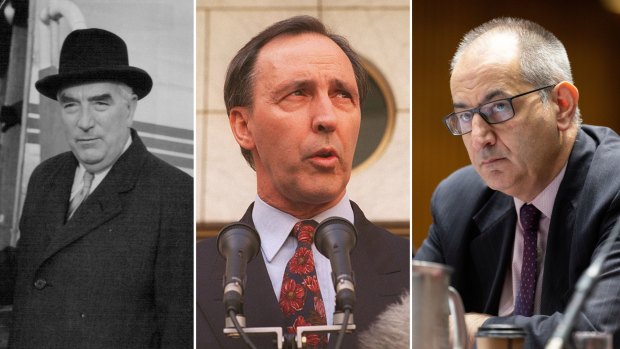Save articles for later
Add articles to your saved list and come back to them any time.
It is perhaps not so curious that a man like Mike Pezzullo, a powerful public servant who tried secretly to insert himself into the intrigues of high politics, felt attracted to the so-called D Notice system to crack down on press freedom.
The D Notice (the D is for Defence) was the invention of the UK defence, intelligence and political worlds early last century to prevent Germany learning through the press confidential details of the British military in the lead-up to World War I.
Former prime ministers Robert Menzies and Paul Keating, and Home Affairs secretary Mike Pezzullo, who has stood aside from his position.
The idea was that British political and intelligence leaders would meet the nation’s powerful press barons and reach quiet agreement on what should be kept secret from the public, and thus from the nation’s enemies.
It is not too fanciful to imagine them meeting in the exclusive gentlemen’s clubs to which they all belonged – a version of the behind-the-scenes networking that goes on these days in the Qantas Chairman’s Lounge.
It was – and in Britain, remains still, though it has grown ragged around the edges – a form of collusion between media owners and the state to hobble journalists.
A subject was chosen (the capability of warships, for instance) and it was agreed this should be suppressed in the media by the issuing of a D Notice. It meant media organisations were under notice that they should voluntarily refrain from publishing material related to the subject.
The D Notice system hasn’t operated in Australia since 1982.
The last time any Australian leader raised the idea of revisiting the D Notice system was in 1995, when journalists at The Sydney Morning Herald and the ABC revealed that the then-new Chinese Embassy in Canberra was riddled with bugs placed by Australian intelligence agencies and the American National Security Agency during construction.
(I was among three Herald journalists, it happens, who hid out in a locked room in Parliament House to ensure an injunction could not be served on us before publication of the story by foreign affairs and defence correspondent David Lague.)
Then prime minister Paul Keating, angered and embarrassed, took a “carrot and stick” approach to any future such reports.
He proposed to media leaders a renewed D Notice system, while also threatening to introduce amendments to the Crimes Act that would make secondary disclosure of official secrets an offence carrying penalties of up to a million dollars. It all went nowhere when the Keating government was voted out in 1996.
Australia adopted the British system in 1952 under the Menzies government, which was still smarting after losing the 1951 referendum to ban the Communist Party.
A PhD thesis by Dr Pauline Sandler in 2000 related that the first meeting of the Defence, Press and Broadcasting Committee, formed from media and defence chiefs to administer the system, took place at Victoria Barracks in Melbourne on July 14, 1952, chaired by Robert Menzies.
The subjects chosen for secrecy covered “UK atomic tests in Australia, aspects of naval shipbuilding, official ciphering, the number and deployment of Centurion tanks, troop movements in the Korean War, weapons and equipment information not officially released, aspects of air defence, and certain aerial photographs”.
In 1974, the original D Notices were reduced to four, including “the whereabouts of Mr and Mrs Vladimir Petrov”, referring to the Soviet diplomats who had defected to Australia at the height of Menzies’ anti-communism drive.
In 1977, a fifth notice concerning the Australian Secret Intelligence Service (ASIS) was issued, which was the first time the existence of ASIS had been admitted, even to parliamentarians.
The last meeting of the committee – 16 media representatives and four from Defence met in 1982 – left four D Notices active: capabilities of the Australian Defence Force, the whereabouts of Mr and Mrs Petrov, signal intelligence, and communications security.
We might never have heard of D Notices again if an angry Mike Pezzullo had not used his covert text messaging system to attempt, in 2019, to persuade then-prime minister Scott Morrison to introduce the old D Notice system to pressure media organisations not to publish stories deemed damaging to national security.
Pezzullo’s attempt, which came to nothing, followed a report by then News Corp journalist Annika Smethurst – who is now state political editor at The Age – about his secret proposal to allow Australia’s external intelligence agency to spy on Australians.
Get the day’s breaking news, entertainment ideas and a long read to enjoy. Sign up to receive our Evening Edition newsletter here.
Most Viewed in National
From our partners
Source: Read Full Article



